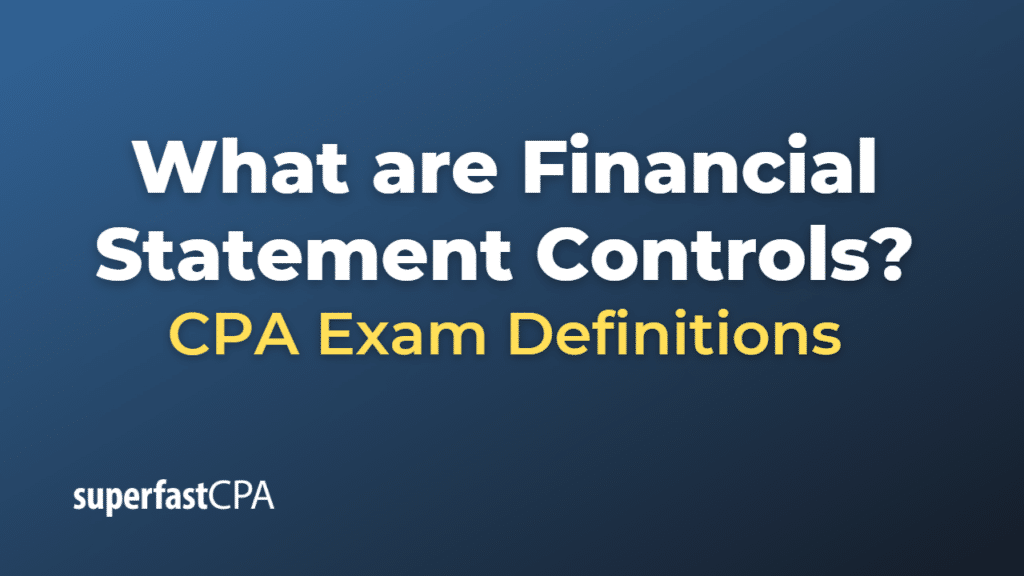Financial Statement Controls
Financial statement controls, often referred to as internal controls over financial reporting, are procedures, policies, and mechanisms implemented by a company to ensure the reliability of its financial reporting and compliance with applicable laws and regulations.
These controls are designed to prevent or detect errors, omissions, fraud, or misstatements in the financial statements. They play a key role in ensuring that the financial statements are free from material misstatement, whether due to error or fraud.
Key areas covered by financial statement controls include:
- Transaction Controls: These controls ensure that transactions are authorized, recorded correctly, and accurately processed by the accounting system. This might include approval processes, segregation of duties (i.e., the person who approves a transaction should not be the one who records it), and regular reconciliation of the accounting records with actual assets (such as cash counts or inventory counts).
- Account Balance Controls: These controls involve verification of the account balances in the financial statements. For instance, regular reconciliation of subsidiary ledgers with the general ledger and validation of asset ownership through physical verification or confirmation from third parties.
- Disclosure Controls: These controls ensure that all necessary disclosures are made in the financial statements, and they are complete, accurate, and in accordance with applicable accounting standards and regulations.
- IT Controls: These controls relate to the IT systems that support financial reporting. This might include access controls (only authorized persons can access the systems), data integrity controls (ensuring data is accurate and has not been tampered with), and change management controls (changes to IT systems are appropriately managed).
- Entity-Level Controls: These controls relate to the ‘tone at the top’ and the overall control environment of the organization. They might include the integrity and ethical values of the management, the company’s commitment to competence, management’s philosophy and operating style, and how the company responds to risks.
Regular testing and review of these controls is an important part of the internal audit function, and external auditors also consider the effectiveness of these controls when conducting a financial statement audit. If these controls are found to be ineffective, it can have significant implications for the reliability of the financial statements, and could potentially lead to financial losses, regulatory penalties, or damage to the company’s reputation.
Example of Financial Statement Controls
Let’s use a fictional company “AutoTech Inc.” which manufactures and sells automotive parts. Here’s how various financial statement controls might look in this company:
- Transaction Controls: When a sale is made, the sales department prepares a sales invoice. This invoice must be approved by a sales manager before it is recorded in the sales journal. This is an example of an authorization control. Additionally, the sales recorded in the journal are regularly reconciled with the invoices issued to ensure accuracy.
- Account Balance Controls: At the end of each month, AutoTech’s accountant reconciles the company’s bank statements with its cash account in the general ledger to ensure the cash balance is accurate. Discrepancies are investigated and resolved.
- Disclosure Controls: AutoTech maintains a checklist of required financial disclosures based on applicable accounting standards. Before the financial statements are finalized, the checklist is reviewed to ensure all necessary disclosures have been made, and are accurate and complete.
- IT Controls: AutoTech’s financial data is stored in a secure accounting software system. Access to this system is controlled by individual user accounts, and permissions are granted based on job responsibilities. Changes to the system are thoroughly tested and approved before implementation.
- Entity-Level Controls: AutoTech’s management promotes a culture of honesty and ethical behavior. The company has a code of conduct that all employees are required to follow, and there is a whistle-blower policy that allows employees to report unethical behavior without fear of retaliation. The board of directors regularly reviews management’s approach to risk management and internal control.
By implementing and maintaining these controls, AutoTech can reduce the risk of errors, fraud, and misstatements in its financial statements, and ensure that its financial reporting is reliable and compliant with relevant regulations.













